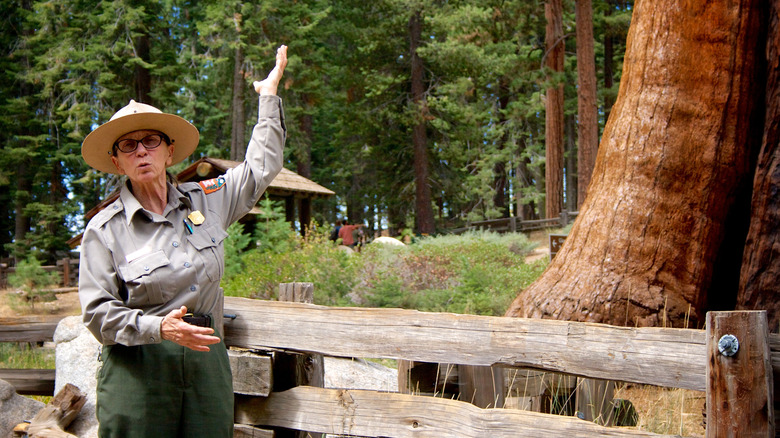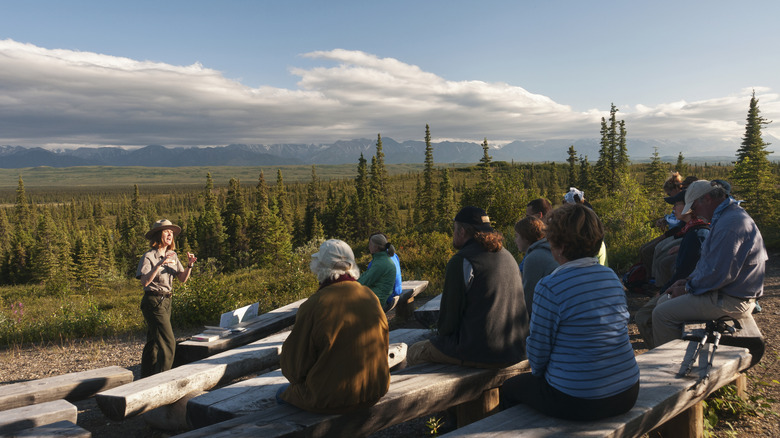How Park Rangers Can Help You Make The Most Of Your National Park Experience
A visit to a national park can be full of awe-inspiring moments, from watching the sun rise over a remote canyon to spotting wildlife in its natural habitat and exploring trails that take your breath away. But it can also be a series of misses: that sunrise blocked by a forest of raised phone cameras, a trail that turns out to be far more challenging than you'd expected, and a day in Yellowstone without a single bison sighting. The secret to turning your trip from so-so to incredible is to talk to a park ranger.
In terms of the parks, there's little a ranger can't do. They're advisors, enforcers, and storytellers, and often the first to administer life-saving first aid in an emergency. They also know where the nearest bathrooms are — an emergency in itself after you've downed gallons of water on a summer hike. So, how exactly can park rangers help you make the most of your experience in a national park?
Where to start in a national park
Rangers themselves recommend making the national park's visitor center your starting point. Once you're in there, let the ranger know how long you have in the park and what your priorities are. If you want to hike, let them know what's manageable for you, and they'll recommend a route. You might want to ask whether there's a trail that's particularly beautiful at that time of year, maybe for spring flowers or fall leaves. Rangers can also give you tips on current safety information, like fire warnings and bear sightings, and let you know if there's a ranger-guided hike happening. Photography buffs can learn about the best viewpoints for each time of day, as well as some quieter spots for unique snaps.
When it comes to animal sightings, rangers tend to know when and where you're most likely to see wildlife in the park. (They're much better at spotting wildlife than the average visitor, trust me!) They can give you crucial tips for staying safe when wildlife viewing. Next time you're in a park, go into the visitor center and ask about these things. Rangers can also let you know what to do if you run into a bear while hiking.
If you're not sure what you want to see or do, you might ask a ranger what the most underrated spot is or what's something most visitors miss. You can keep it even simpler and ask, "What's your favorite thing to do if you have a free day in the park?"
Learn from a ranger
On top of the practical advice about where to go and what to do in the parks, rangers can offer so much more. We mentioned guided hikes, but rangers don't just lead you in the right direction. They point out landmarks, share information on the geologic and natural history of the park, and help you learn about its unique flora and fauna. Many national parks offer ranger-led daytime and evening talks to provide more insights into these areas. Many parks also offer stargazing programs as well as activities for those with special interests. For example, there's the Native America Speaks program in Glacier National Park with Native storytelling and singing, and in South Dakota's Badlands, you can participate in geology and prairie walks.
I can personally attest to the power of rangers in parks all over America. In Denali, my husband and I watched a sled dog demonstration, while down in Death Valley, we gazed in awe at the Milky Way as a ranger pointed out constellations. In Glacier, we learned that bears give birth in their dens, with Mom snoozing and nursing her cubs until they all emerge in spring. (Were we the only ones who didn't know that?) And perhaps most significantly, in Saguaro, a well-timed ranger encounter stopped us from straying off the trail and being swallowed by a jungle of cactuses. If you want a taste of the wisdom you might receive from a ranger, check out the National Park Service's Instagram or X (formerly Twitter) accounts.


